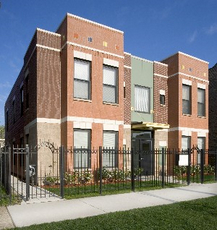Shared appreciation loans are structured as second mortgages, but are
considered "silent" in that borrowers make no payments until they sell
the home (or, in some cases, refinance the first mortgage). At the
time of sale or refinance, the family is required to repay the full amount of the
loan plus a portion of the home price appreciation.
In this way, the
amount returned to the subsidizing entity is based on increases in home
prices, which helps to preserve the "buying power" of public subsidies.
One common approach to designing shared appreciation loan programs is
to base the share of appreciation payable upon sale of the home on the
share of the original purchase price that was subsidized.
For example,
if a family received a $50,000 subsidy to buy a $250,000 home, the
family would be required to give the community 20 percent ($50,000 divided by
$250,000) of any home price appreciation at the time of sale, in
addition to repaying the initial $50,000.
| 
Photo credit: Mark Ballogg, Ballogg Photography, Inc., courtesy of Landon Bone Baker
|
The repayment of subsidy plus a share of appreciation helps the community fill the gap for the next family, but it still may not be enough to help a similarly situated family buy a similar home if housing prices rise faster than incomes. Some communities may decide that they are willing to provide additional subsidy to the next buyer to enable greater asset accumulation by the original beneficiary. But communities that wish to ensure the subsidy fully keeps pace with the market may wish to select a different resale formula.
Learn more about resale formulas.
Other shared appreciation programs establish the percentage of appreciation that is retained by the homeowner in other ways. For example, some programs offer all sellers a given percentage of appreciation, say, 40 percent, regardless of their contribution to the purchase price or the amount of subsidy they originally received.
When units are created through
inclusionary zoning -- programs that mandate or incentivize the inclusion of a modest share of affordable homes within new developments and sold initially at below market prices -- jurisdictions sometimes impose shared appreciation requirements tied to the homeowner's purchase price as a percentage of appraised value. So, for example, a homeowner who purchased his or her home with a 25 percent discount due to an inclusionary housing program could owe the jurisdiction 25 percent of any future appreciation upon sale, in addition to repayment of the subsidy implicit in the discounted price.
Solutions in Action
|
Santa Cruz, California, a city with one of the least affordable housing markets in the country, offers loans to homebuyers that must be paid back in full upon resale. Instead of interest, borrowers pay the city one percentage point of the home price appreciation for every percentage point of the purchase price funded by the city's second mortgage program. For example, down payment assistance equal to 20 percent of the home purchase price would, upon sale of the home, require repayment of the principal balance plus 20 percent of home price appreciation.
Emeryville, California provides silent second mortgages of up to 15 percent of the purchase price to buyers with incomes below 120 percent of area median. After sale of the property, participating borrowers must repay the principal of the loan in addition to either a low-rate interest payment or a share of the appreciated value of the home, whichever is greater. The interest figure is equivalent to 75 percent of the interest on a first mortgage up to a maximum of 5 percent. The share of the appreciated value of the home owed to the City is equal to the percentage of the total value of the home that was loaned less the value of any capital improvements made since purchase of the home.
|
You are currently reading:
Shared appreciation loans
Homebuyers
that receive these "silent" second mortgages make no payments until
sale of the home, at which time the full loan is repaid plus a share of
the home price appreciation.
Also in this section:
 Subsidy retention strategies Subsidy retention strategies
Subsidy
retention programs subsidize the unit, rather than the buyer, ensuring
a specific home remains affordable over the long term.
 Implementing shared equity approaches Implementing shared equity approaches
Key issues related to designing a shared equity policy.
 Resident acquisition of manufactured home parks Resident acquisition of manufactured home parks
By
facilitating the cooperative purchase by residents of manufactured home
parks, communities can preserve affordable housing opportunities and
help residents gain stability and build assets.
Click here to view other resources related to shared equity homeownership.
|
 Subsidy retention strategies
Subsidy retention strategies Resident acquisition of manufactured home parks
Resident acquisition of manufactured home parks